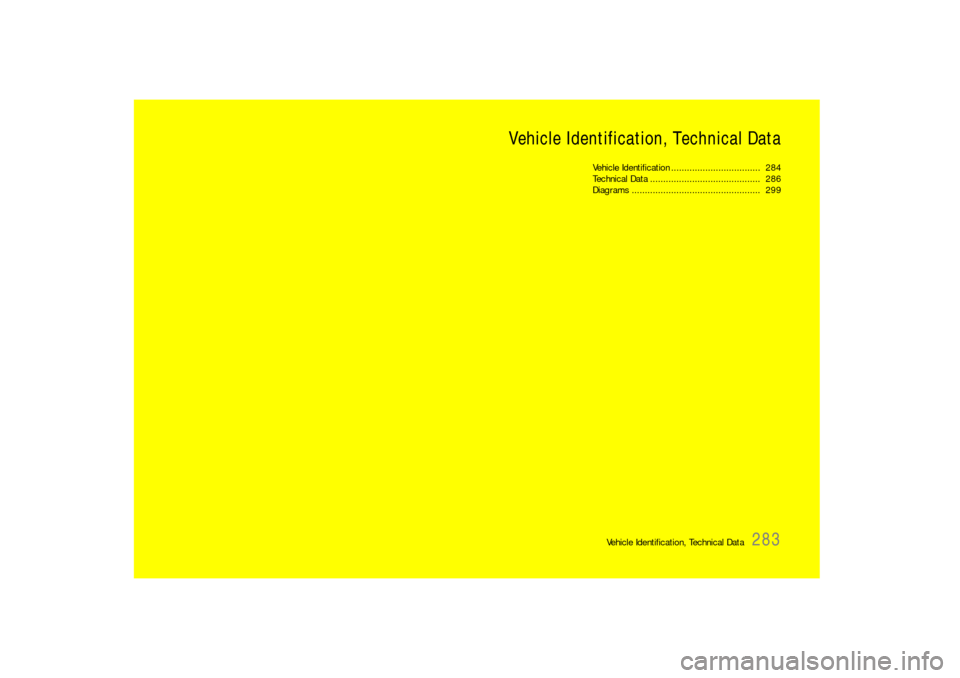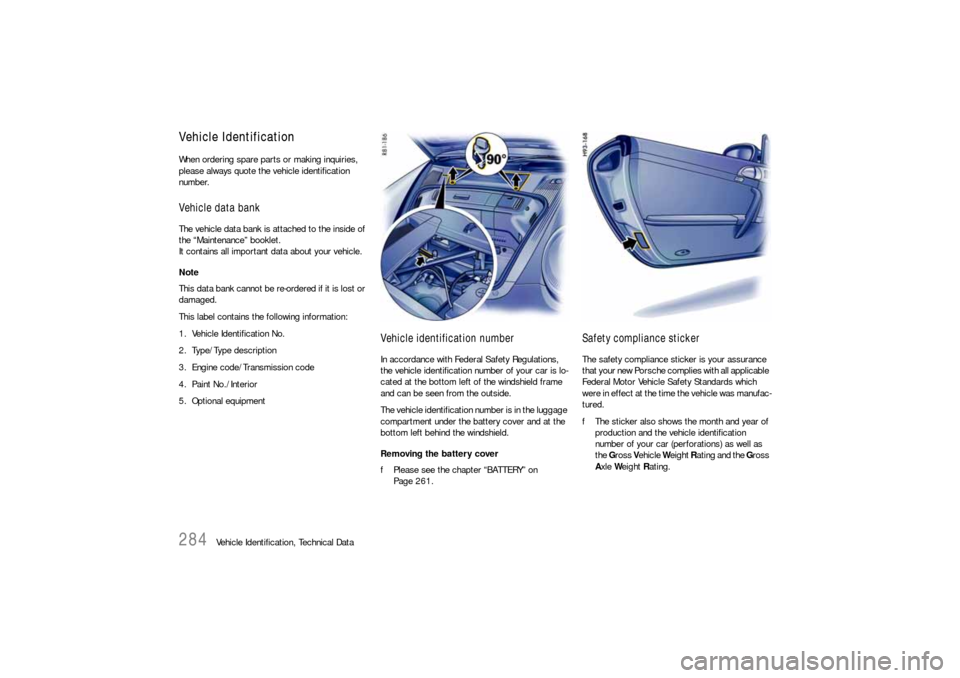technical data PORSCHE 911 2009 5.G Owners Manual
[x] Cancel search | Manufacturer: PORSCHE, Model Year: 2009, Model line: 911, Model: PORSCHE 911 2009 5.GPages: 310, PDF Size: 3.39 MB
Page 9 of 310

Table of Contents
7
Speedometer ............................................ 118
Changing over between Miles / Kilometers .. 118
Tachometer ............................................... 119
Turn Signal Indicator Light .......................... 119
High Beam Indicator Light........................... 119
Gear Shift Indicator “A”
(in vehicles with manual transmission).......... 119
Cooling System ......................................... 120
Porsche Doppelkupplung (PDK) ................... 121
Fuel .......................................................... 122
Clock ........................................................ 123
Outside Temperature .................................. 123
Engine Oil Pressure .................................... 124
Check Engine (Emission Control) ................. 125
On-Board Computer (BC) ............................ 126
Warnings on the instrument panel
and the on-board computer......................... 158Shifting Gears................................. 167Manual Transmission, Clutch ....................... 168
Drive-Off Assistant ..................................... 169
Porsche Doppelkupplung (PDK) ................... 170Mobile Roofs .................................. 177 Lifting/Sliding Roof .................................... 178
Convertible Top ......................................... 181
Emergency operation of the convertible top . 183
Windstop................................................... 190
Hardtop .................................................... 194
Targa ........................................................ 200
Roof Transport System............................... 204
Maintenance, Car Care ................... 205Exercise Extreme Caution when Working
on your Vehicle .......................................... 206
Coolant Level............................................. 207
Engine Oil .................................................. 208
Engine Oil Level ......................................... 208
Engine Oil Recommendation........................ 210
Brake Fluid Level........................................ 212
Fuel Economy ............................................ 214
Operating your Porsche in other Countries ... 214
Fuel Recommendations .............................. 216
Portable Fuel Containers............................. 217
Fuel Evaporation Control ............................. 217
Emission Control System ............................ 218
How Emission Control Works ...................... 219
Washer Fluid .............................................. 220
Power Steering .......................................... 221
Air Filter .................................................... 222
Combination Filter ...................................... 222
Fluids/Oils for Manual Transmission
and Porsche Doppelkupplung (PDK) ............. 222
Wiper Blades ............................................. 223
Car Care Instructions.................................. 224Practical Tips, Emergency Service ... 233Exercise Extreme Caution when Working
on your Vehicle .......................................... 234
Tires/Wheels ............................................. 235
Loading Information ................................... 246
Wheel Bolts ............................................... 248
Changing a wheel....................................... 249
Flat Tire..................................................... 251Lifting the Vehicle with a Lifting Platform or
Garage Lift ............................................... 254
Spacers 911 Carrera, 911 Carrera S ......... 255
Electrical System ...................................... 257
Battery ..................................................... 261
Replacing the remote-control battery .......... 266
Emergency Starting with Jumper Cables ..... 267
Bulb chart................................................. 269
Lights, Replacing Bulbs.............................. 269
Headlights ................................................ 270
Number Plate Light.................................... 277
Changing Light-Emitting Diodes and
Long-Life Bulbs ......................................... 277
Adjusting Headlights .................................. 278
Towing ..................................................... 280
Vehicle Identification,
Technical Data ............................... 283Vehicle Identification.................................. 284
Technical Data .......................................... 286
Diagrams ................................................. 299
Page 154 of 310

152
Instruments, On-Board Computer, Warnings
No monitoringIn the event of faults the Tire Pressure Monitoring
cannot monitor the tire pressure.
The warning light in the speedometer flashes for
approx. one minute and then remains continuously
illuminated and a corresponding message
appears on the on-board computer.
Monitoring is not active when:
– the Tire Pressure Monitoring is faulty,
– wheel transmitters for the Tire Pressure
Monitoring are missing,
– during the learning phase after the tire settings
have been updated,
– after a wheel change without updating the tire
settings,
– more than four wheel transmitters are
detected,
– there is external interference by other radio
sources, e.g. wireless headphones,
– tire temperatures are too high.
fPlease see the chapter “WARNINGS ON THE
INSTRUMENT PANEL AND THE ON-BOARD
COMPUTER” on Page 158.
Pressure increase as the result of
temperature increaseIn accordance with physical principles, the air
pressure changes as the temperature changes.
The tire pressure increases or decreases by
around 1.5 psi (0.1 bar) for every 18 °F (10 °C)
change in temperature.
The Tire Pressure Monitoring takes this relation-
ship between tire pressure and temperature into
account.Tire pressure specificationsInformation on tire pressure for public roads can
be found in this Owner's Manual in the Technical
Data chapter or on the tire-pressure plate in the
left door aperture.
These values apply to cold tires at 68 °F (20 °C)
ambient temperature.
Page 239 of 310

Practical Tips, Emergency Service
237
Each tire, should be checked every 2 weeks when
cold (68 °F/20 °C) and inflated to the inflation
pressure recommended in this Owner's Manual or
on the tire-pressure plate.
If your vehicle has tires of a different size than the
size indicated in this Owner's Manual or on the tire-
pressure plate, you should determine the proper
tire inflation pressure for those tires.
As an added safety feature, your vehicle has been
equipped with a tire pressure monitoring (TPM)
that illuminates a low tire pressure message when
one or more of your tires is significantly under-in-
flated. Accordingly, when the low tire pressure
message illuminates, you should stop and check
your tires as soon as possible, and inflate them to
the proper pressure. Driving on a significantly un-
der-inflated tire causes the tire to overheat and
can lead to tire failure. Under-inflation also reduc-
es fuel efficiency and tire tread life, and may affect
the vehicle’s handling and stopping ability.
Please note that the TPM is not a substitute for
proper tire maintenance, and it is the driver’s re-
sponsibility to maintain correct tire pressure, even
if under-inflation has not reached the level to trig-
ger illumination of the TPM low tire pressure mes-
sage.
fOn vehicles with tire pressure monitoring:
Please see the chapter “TPM TIRE PRESSURE
MONITORING” on Page 143.
When tires are warm, the tire pressure is
increased.fNever let air out of hot tires.
This could cause the tire pressure to fall below
the prescribed value.
Insufficient tire filling pressure can cause tires to
overheat and thus be damaged – even invisibly.
Hidden tire damage is not eliminated by subse-
quently correcting the tire pressure.
Overloading
Danger!
Risk of damage to vehicle parts, loss of con-
trol and serious personal injury or death.
fDo not overload your vehicle. Be careful about
the roof load.
fIf loading the vehicle also correct the tire pres-
sure. Tire pressure for loaded vehicle can be
found on the tire pressure plate and in the
chapter technical data.
fNever exceed the specified axle load.
Overloading can shorten the service life of the
tires and car, as well as lead to dangerous ve-
hicle reactions and long braking distances.
Damage due to overloading is not covered by the vehicle warranty.
fPlease see the chapter “LOADING INFORMA-
TION” on Page 246.
fPlease see the chapter “TIRE PRESSURES FOR
COLD TIRES (68 °F / 20 °C)” on Page 289.
Example of a tire pressure plateTire pressure plateInformation on the tire pressure plate
A Seating capacity
Maximum number of vehicle occupants, inclu-
ding the driver.
Page 245 of 310

Practical Tips, Emergency Service
243
Snow chains
Caution!
Risk of damage to body, axle or brake com-
ponents.
fFit snow chains only to the rear wheels, and
only with the tire/rim combination listed in the
Technical Data.
To ensure adequate clearance between chain
and body, Porsche recommends only the use
of fine-link chains such as those approved by
Porsche.
fFollow instructions issued by the supplier of the chains.
Different states and countries have varying statu-
tory requirements regarding maximum speed.
Check with local authorities for possible restric-
tions.
fRemove chains as soon as the roads are free
of ice and snow. 911 Carrera, 911 Carrera S
Fitting snow chains
The use of snow chains is not permitted when
5 mm spacers are mounted.
Caution!
Risk of damage to the wheel housings if the
5 mm spacers are not removed before fitting
snow chains.
fTo permit the fitting of snow chains, have the 5 mm spacers removed on all 4 wheels.
fTo fit/remove the spacers:
Please consult an authorized Porsche dealer.
fPlease see the chapter “SPACERS 911
CARRERA, 911 CARRERA S” on Page 255.
Tire designations Due to new speed and load ratings for radial tires,
new designations have come into force for snow
tires for your Porsche.
The designation to be used for ZR tires is e.g.,
265/40 ZR 18 (Z = code letter for radial tires for
speeds above 150 mph / 240 km/h).
Page 248 of 310

246
Practical Tips, Emergency Service
Loading InformationDefinitionsThe Curb weight - actual weight of your vehicle -
vehicle weight including standard and optional
equipment, fluids and emergency tools. This
weight does not include passengers and cargo.
The Gross Vehicle Weight is sum of the curb
weight and the weight of passengers and cargo
combined.
The Gross Vehicle Weight Rating is the maxi-
mum total weight of vehicle, passengers, luggage
and optional equipment.
The Gross Axle Weight Rating is the maximum
load limit for the front or the rear axle. This infor-
mation is located on the safety compliance sticker
located in the driver’s side door jamb.
For determining the compatibility of the tire and
vehicle load capabilities:
fPlease see the chapter “TECHNICAL DATA” on
Page 286.
The load capacity coefficient (e.g. “100”) is a min-
imum requirement.The Gross Combined Weight Rating is the
maximum total weight rating of vehicle, passen-
gers and cargo.
The Vehicle Capacity Weight - Load Limit - is
the maximum total weight limit specified of the
load (passengers and cargo) for the vehicle. This
is the maximum weight of passengers and cargo
that can be loaded into the vehicle. This informa-
tion can be found on the tire pressure plate.
The maximum loaded vehicle weight is the
sum of curb weight, accessory weight, vehicle ca-
pacity weight and production options weight.
The load rating is the maximum load that a tire
is rated to carry for a given inflation pressure.
The maximum load rating is the load rating for
a tire at the maximum permissble inflation pres-
sure.
The cargo capacity is the permissible weight of
cargo, the substracted weight of passengers from
the load limit.
fNever exceed the permissible limits.
Danger!
Risk of loss of control, damage to the vehicle
and serious personal injury or death.
fNever exceed the specified axle loads.
Overloading can shorten the service life of the
tires and car, as well as lead to dangerous
vehicle reactions and long braking distances.
Damage due to overloading is not covered by the vehicle warranty.
Page 252 of 310

250
Practical Tips, Emergency Service
Screw in two assembly aids for vehicles with Porsche
Ceramic Composite Brake10.Take the wheel off and put a new wheel on.
Please see the chapter “WHEEL BOLTS” on
Page 248.
11.Insert wheel bolts and tighten by hand.
12.Remove assembly aids, screw in remaining
wheel bolts.
Initially tighten bolts only slightly in diagonally
opposite sequence so that the wheel
is centred.13.Inflate the tire if necessary.
Please see the chapter “TIRE PRESSURES FOR
COLD TIRES (68 °F / 20 °C)” on Page 289.
14.Lower the car fully and remove the jack.
15.Tighten wheel bolts in diagonally opposite
sequence.
fImmediately after changing a wheel, use
a torque wrench to check the prescribed
tightening torque (96 ftlb./130 Nm).
Note on operation for vehicles with
Tire Pressure Monitoring
fOn vehicles with Tire Pressure Monitoring, the
settings on the on-board computer must be
updated after the wheel change.
fPlease see the chapter “TPM TIRE PRESSURE
MONITORING” on Page 143.
Checking tire pressure with a
pressure gage1. Remove the valve stem cap from the tire.
2. Press the pressure gage onto the valve stem.
Note on operation
fDo not press too hard or force the valve stem
sideways, or air will escape.
If the sound of air escaping from the tire is
heard, reposition the pressure gage.
3. Read the tire pressure on the gage stem and
compare it to the permissble tire pressure.
This information can be found on the tire pres-
sure plate or in the chapter Technical Data.
Please see the chapter “TIRE PRESSURES FOR
COLD TIRES (68 °F / 20 °C)” on Page 289.
4. Remove the pressure gage.
fPlease see the chapter “TPM TIRE PRESSURE
MONITORING” on Page 143.
Page 285 of 310

Vehicle Identification, Technical Data
283 Vehicle Identification, Technical Data
Vehicle Identification.................................. 284
Technical Data .......................................... 286
Diagrams ................................................. 299
Page 286 of 310

284
Vehicle Identification, Technical Data
Vehicle IdentificationWhen ordering spare parts or making inquiries,
please always quote the vehicle identification
number. Vehicle data bankThe vehicle data bank is attached to the inside of
the “Maintenance” booklet.
It contains all important data about your vehicle.
Note
This data bank cannot be re-ordered if it is lost or
damaged.
This label contains the following information:
1. Vehicle Identification No.
2. Type/Type description
3. Engine code/Transmission code
4. Paint No./Interior
5. Optional equipment
Vehicle identification number In accordance with Federal Safety Regulations,
the vehicle identification number of your car is lo-
cated at the bottom left of the windshield frame
and can be seen from the outside.
The vehicle identification number is in the luggage
compartment under the battery cover and at the
bottom left behind the windshield.
Removing the battery cover
fPlease see the chapter “BATTERY” on
Page 261.
Safety compliance stickerThe safety compliance sticker is your assurance
that your new Porsche complies with all applicable
Federal Motor Vehicle Safety Standards which
were in effect at the time the vehicle was manufac-
tured.
fThe sticker also shows the month and year of
production and the vehicle identification
number of your car (perforations) as well as
the Gross Vehicle Weight Rating and the Gross
Axle Weight Rating.
Page 287 of 310

Vehicle Identification, Technical Data
285
Tire pressure plateThe tire pressure plate is attached to the left-hand
door aperture.
Engine number The engine number is stamped on the underside
of the crankcase.
Page 288 of 310

286
Technical Data
Technical DataEngine data
911 Carrera, 911 Carrera 4,
911 Targa 4911 Carrera S, 911 Carrera 4S,
911 Targa 4S911 Carrera S, 911 Carrera 4S,
911 Targa 4S
Power kit Carrera
Type MA 102 MA 101 MA 101S
Horizontally opposed engine,
liquid cooledHorizontally opposed engine,
liquid cooledHorizontally opposed engine,
liquid cooled
Number of cylinders 6 6 6
Bore 3.82 in./97 mm 4.02 in./102 mm 4.02 in./102 mm
Stroke 3.21 in./81.5 mm 3.05 in./77.5 mm 3.05 in./77.5 mm
Cubic capacity 220.5 cu. in./3614 cm
3 231.9 cu. in./3800 cm
3
231.9 cu. in./3800 cm
3
Net-horsepower 345 hp/254 kW385 hp/283 kW 408 hp/300 kW
at crankshaft speed 6500 rpm 6500 rpm 7300 rpm
Net torque 288 ft. lb./390 Nm 310 ft. lb./420 Nm 310 ft. lb./420 Nm
at crankshaft speed 4400 rpm 4400 rpm 4400 - 5800 rpm
Engine oil consumption up to 1.5 liters/1000 km
(1.6 quarts/622 miles)up to 1.5 liters/1000 km
(1.6 quarts/622 miles)up to 1.5 liters/1000 km
(1.6 quarts/622 miles)